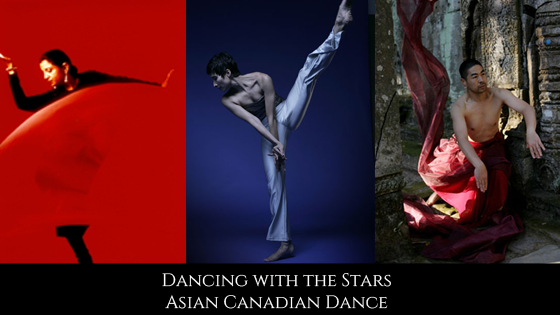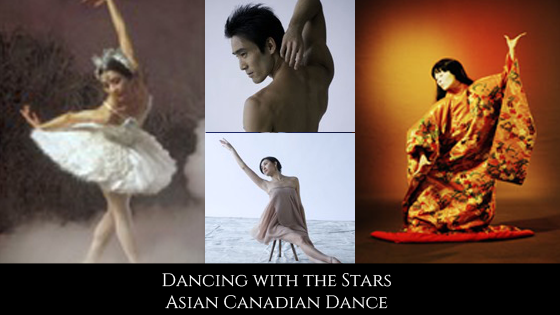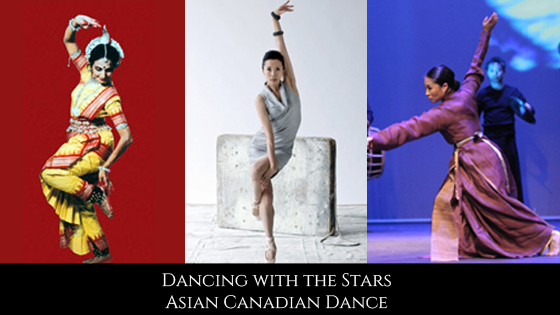Dancing with the Stars
Asian Canadian Dance
Dancing with the Stars
Canada is home to many great Asian Canadian dancers and choreographers. Dance, to them, is not just movements, but a personal quest. Lata Pada, the founder and artistic director of Sampradaya Dance Creations, brings a contemporary worldview to her art. She is dedicated to showcasing bharatanatyam as a world art form as it explores diverse movement styles, contemporary themes and innovative collaborations. Peter Chin, Artistic Director of Tribal Cracking Wind, is an award-winning multidisciplinary artist born in Kingston, Jamaica and based in Toronto. He is active as a musician/composer, dancer/choreographer, performance artist, designer and director. Yvonne Ng is a choreographer, presenter, producer, curator, arts educator and artistic director of princess productions (since 1996), which houses tiger princess dance projects and the dance: made in canada/fait au canada Festival. To Alvin Erasga Tolentino, who was born in the Philippines, dance creations are driven by the need to intricately illustrate human experiences of light and darkness, and the infinitely complex relationship between nature and humanity. His choreography challenges the exploration of hybridity that juxtapose to reveal the private and public territory empowering the issues within the traditional and contemporary cross-cultural dialogue. Denise Fujiwara is a seasoned choreographer, dancer, actor, dance impresario and teacher. She formed her own company, Fujiwara Dance Inventions, to house the development of her exquisite solo concerts. Asian Canadian dancers and choreographers do not just present ethnic dances, they also reinterpret them in their Canadian contexts. Kwon Soojung is interested in creating original works of contemporary Korean dance. She is also dedicated to re-interpreting traditional dance genres.
The artists' choreography reflects their intercultural position in Canada. Fu-GEN (Future Generation) strives to empower Asian-Canadian theatre artists to create and work with material that examines contemporary issues. The demographic of Asian Canadians with whom fu-GEN usually works are those who exist not between cultures, but as part of Canada's culture as a whole. Menaka Thakkar is a master dancer in three classical Indian styles - Bharatanatyam, Odissi and Kuchipudi. She has created groundbreaking choreographies since coming to Canada that reflect both her exposure to western dance styles and her background in classical Indian dance. Her students include Natasha Bakht, a contemporary Indian dancer and choreographer, Obiter Dictum was nominated for a 2003 Dora Mavor Moore Award for Outstanding New Choreography. Devraj Patnaik, Artistic Director of the Patnaik Family, has dedicated himself chiefly to the Odissi style of dance. In music composition, his talent spans the Indian Classical field. He co-founded Chitralekha Odissi Dance Creations Incorporated (CODC) with his mother, Chitralekha and his elder sister, Ellora, a well-known dancer and actress.
Asian Canadian dance artists are beautiful and elegant. Chan Hon Goh, a principal dancer in The National Ballet of Canada (NBC), has employed her delicate lyricism and emotional depth to personify the essence of lead roles in ballets such as Romeo and Juliet, Swan Lake, The Sleeping Beauty, Onegin and the title roles in Giselle, Madame Butterfly and La Sylphide. Another principal dancer of the NBC is Xiao Nan Yu from China. She has performed lead roles in The Merry Widow, Balanchine's Don Quixote, Four Temperaments, Swan Lake, Onegin, Giselle, Romeo and Juliet, The Sleeping Beauty, Theme and Variations, The Nutcracker, Apollo, The Firebird, Song of the Earth, Opus 19/The Dreamer and Voluntaries. Also at the NBC, Juri Hiraoka has danced a featured role in Wolf's Court as well as roles in pieces such as The Nutcracker, Swan Lake, Cinderella, Romeo and Juliet, Onegin, The Sleeping Beauty, The Contract (The Pied Piper), Giselle and The Taming of the Shrew. Keiichi Hirano, NBC first soloist, created roles in James Kudelka's An Italian Straw Hat and Cinderella and danced in the world premieres of Matjash Mrozewski's A Delicate Battle and John Alleyne's Tristan and Isolde. Wei Chan from China joined the NBC in 2008 as a member of the Corps de Ballet.
Their artistry also reflects the adaptation of their art to their new home, Canada. Noriko Yamamoto from Japan is a professional dancer, choreographer, mime, clown, "Silent Storyteller" and visual artist (sculpture and mixed-media painting. Upon moving to Canada and with little knowledge of the English language, Noriko developed Silent Storytelling to tell stories without the use of spoken words.
They are colourful and energetic with a wide repertoire. Chi Ping Dance Group aims to promote multiculturalism and the richness of Chinese heritage through Chinese dance. The group provided opportunities for young Canadians to better understand Chinese culture and enhance their performing skills through the opportunity to preform in classical, folk and contemporary dance styles. At the Hong Luck Kung Fu Club, Sifu Chan and his students practice the Choi Lee Fut and Do Pi systems of traditional kung fu, and the curriculum also includes Hei Gong (energy training), San Shou (sparring) and the Lion Dance. Traditionally, the fearsome aspect of the lion and the loud, raucous music of its accompanying drum, gong and cymbals meant that the Lion Dance was thought to drive away evil spirits and bring good luck.
Asian Canadian dance companies are crucial in celebrating Canada's multiculturalism. The Karilagan Dance Society performs ethnic Philippine dances during Heritage Days, Canada Day, Promenade and Klondike Days, as well as at hospitals, extended care centres, schools, churches and many other fundraising and cultural events.
Asian Canadian Dance Festivals aspire to be culturally inclusive. CanAsian Dance Festival fosters and promotes diverse expressions of Asian aesthetics through dance in Canada. In addition to the festival, the group presents annual artistic, educational and professional development activities on an ongoing basis, often in partnership with other like-minded organizations.



